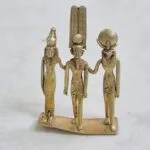Fossils of the oldest saber-toothed predator shed light on gorgonopsian evolution, early mammal relatives, and our shared ancestry within the therapsid group, offering valuable insights into the development of prehistoric life and its connection to modern species.
Headlines
Ancient Saber-Toothed Predator from ‘Ghost Lineage’ Resembled a Bald Dog

Scientists have unearthed what they believe to be the oldest saber-toothed animal ever discovered—a peculiar, furless predator roughly the size of a husky. This creature, part of a “ghost” lineage of ancient mammal relatives, roamed the Earth around 280 to 270 million years ago. Its discovery is shedding new light on the evolution of early therapsids, a group of mammal-like reptiles from which modern mammals eventually evolved.
The fossilized remains were detailed in the journal Nature Communications on December 17. Although researchers could not identify its exact species, they confirmed the animal belonged to the gorgonopsians, an extinct branch of therapsids. Gorgonopsians, though not direct ancestors of modern mammals or saber-toothed cats like Smilodon, are vital pieces of the evolutionary puzzle, representing an early step in the development of mammalian traits.
Kenneth D. Angielczyk,, a curator of paleomammalogy at the Field Museum in Chicago, explained that while therapsid fossils date back approximately 270 million years, scientists believe therapsids first evolved around 300 million years ago. This timeline leaves a substantial gap in the fossil record, often referred to as a “ghost lineage.” The newly discovered gorgonopsian, dated to roughly 280 to 270 million years ago, belongs to this elusive lineage, providing crucial evidence of therapsid evolution during this enigmatic period.
This ancient predator not only deepens our understanding of therapsids but also highlights the complexity of the evolutionary journey that eventually led to mammals. Its discovery serves as a significant step toward unraveling the mysteries of our prehistoric origins, bridging gaps in the fossil record and offering new perspectives on life during the Permian era.
“Our new gorgonopsian helps to fill in a major time gap in the fossil saber record of ancient mammal relatives,” Angielczyk said.
Researchers discovered the new gorgonopsian fossils on the Spanish island of Mallorca. In the age of the gorgonopsians, this Mediterranean island would have been part of the ancient supercontinent Pangaea, according to a statement released by the Field Museum.

Figure from the paper showing the fossil bones that have been found of the new gorgonopsian. (Image credit: Matamales-Andreu et al, illustration by Eudald Mujal / SMNS)
The fossilized remains of this ancient predator included fragments of its skull, serrated blade-like teeth, jawbones, ribs, and part of a hind leg. From these fragments, researchers estimated that the creature was about the size of a modern dog. Despite the intriguing find, the fossils were too fragmented for the team to confirm whether they represented a previously unknown species.
Kenneth D. Angielczyk, a curator at the Field Museum, explained, “Although the specimen has several features that let us confidently identify it as a gorgonopsian, it is too incomplete to determine if it belongs to a new or previously described species. A more complete specimen could eventually allow us to give it a formal species name.”
While uncertainties remain about its exact placement in the gorgonopsian lineage, the discovery saber offers crucial insights into therapsid evolution. Gorgonopsians were part of the therapsid group, a lineage that eventually gave rise to mammals. These fossils predate the oldest known gorgonopsian and could potentially be older than the therapsid species Raranimus dashankouensis, making them some of the earliest evidence of therapsid diversification.
This saber-toothed predator was likely a dominant force in its ecosystem, showcasing powerful, serrated teeth ideal for hunting and solidifying its status as a top saber predator. Its presence indicates that therapsids were diversifying into various forms earlier than previously believed. Angielczyk noted, “Therapsid diversification was well underway by about 280 million years ago, which is farther back in time than we had thought. This may have occurred following an extinction event that eliminated earlier competitors.”
The discovery not only fills gaps in the fossil record but also highlights a pivotal moment in evolutionary history when therapsids began to dominate terrestrial ecosystems, paving the way for the eventual rise of mammals.






